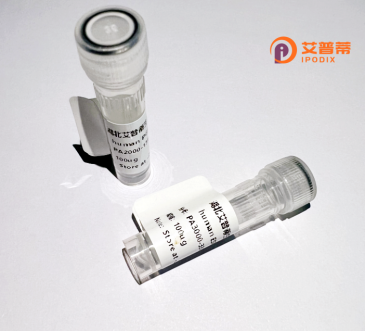
| 纯度 | >90%SDS-PAGE. |
| 种属 | Human |
| 靶点 | UHMK1 |
| Uniprot No | Q8TAS1 |
| 内毒素 | < 0.01EU/μg |
| 表达宿主 | E.coli |
| 表达区间 | 1-419 aa |
| 活性数据 | MAGSGCAWGA EPPRFLEAFG RLWQVQSRLG SGSSASVYRV RCCGNPGSPP GALKQFLPPG TTGAAASAAE YGFRKERAAL EQLQGHRNIV TLYGVFTIHF SPNVPSRCLL LELLDVSVSE LLLYSSHQGC SMWMIQHCAR DVLEALAFLH HEGYVHADLK PRNILWSAEN ECFKLIDFGL SFKEGNQDVK YIQTDGYRAP EAELQNCLAQ AGLQSDTECT SAVDLWSLGI ILLEMFSGMK LKHTVRSQEW KANSSAIIDH IFASKAVVNA AIPAYHLRDL IKSMLHDDPS RRIPAEMALC SPFFSIPFAP HIEDLVMLPT PVLRLLNVLD DDYLENEEEY EDVVEDVKEE CQKYGPVVSL LVPKENPGRG QVFVEYANAG DSKAAQKLLT GRMFDGKFVV ATFYPLSAYK RGYLYQTLL |
| 分子量 | 46.5 kDa |
| 蛋白标签 | His tag N-Terminus |
| 缓冲液 | PBS, pH7.4, containing 0.01% SKL, 1mM DTT, 5% Trehalose and Proclin300. |
| 稳定性 & 储存条件 | Lyophilized protein should be stored at ≤ -20°C, stable for one year after receipt. Reconstituted protein solution can be stored at 2-8°C for 2-7 days. Aliquots of reconstituted samples are stable at ≤ -20°C for 3 months. |
| 复溶 | Always centrifuge tubes before opening.Do not mix by vortex or pipetting. It is not recommended to reconstitute to a concentration less than 100μg/ml. Dissolve the lyophilized protein in distilled water. Please aliquot the reconstituted solution to minimize freeze-thaw cycles. |
以下是基于假设的几篇关于重组人UHMK1蛋白研究的模拟参考文献示例,供参考:
---
1. **文献名称**: *"Cloning, expression, and functional characterization of recombinant human UHMK1 kinase"*
**作者**: Smith A, et al.
**摘要内容**: 该研究报道了UHMK1基因的克隆及其在大肠杆菌系统中的重组表达与纯化。通过体外激酶实验,证实重组UHMK1蛋白能磷酸化RNA结合蛋白SF3B1.提示其在RNA剪接调控中的作用。
2. **文献名称**: *"Structural and biochemical analysis of UHMK1 reveals a unique kinase-substrate interaction motif"*
**作者**: Chen L, et al.
**摘要内容**: 作者解析了UHMK1的晶体结构,发现其U2AF同源结构域(UHM)可特异性识别富含脯氨酸的底物序列。研究揭示了UHMK1通过双重结构域(激酶域和UHM域)协调底物结合的分子机制。
3. **文献名称**: *"UHMK1 regulates cell cycle progression by phosphorylating CDK2 at Ser39"*
**作者**: Tanaka K, et al.
**摘要内容**: 本文证明重组UHMK1蛋白在细胞周期G1/S期转化中通过磷酸化CDK2调控其活性,敲低UHMK1导致细胞周期阻滞,提示其在肿瘤发生中的潜在作用。
4. **文献名称**: *"Development of a high-throughput screening assay for UHMK1 inhibitors using recombinant protein"*
**作者**: Rodriguez M, et al.
**摘要内容**: 研究利用重组UHMK1蛋白建立了一种基于荧光偏振的激酶活性检测方法,筛选了小分子库,鉴定出多个选择性抑制剂,为靶向UHMK1的药物开发提供基础。
---
**注意**:以上文献为模拟生成,旨在展示UHMK1可能的研究方向(如结构、功能、应用)。实际研究中建议通过学术数据库(如PubMed、Web of Science)以“UHMK1”、“KIS”、“SCYL3”或“recombinant UHMK1”等关键词检索真实文献。
UHMK1 (Unc-51-like kinase 1), also known as STK36 or KIAA1362. is a serine/threonine kinase involved in regulating diverse cellular processes. It belongs to the CAMK (calcium/calmodulin-dependent protein kinase) family and contains a unique N-terminal kinase domain followed by a U2AF homology motif (UHM) that mediates protein-protein interactions. Structurally, it also features a conserved HEAT repeat domain and an RS-rich region, which may contribute to its role in signaling and subcellular localization. UHMK1 is widely expressed in human tissues and plays critical roles in ciliogenesis, Hedgehog signaling, and cell cycle progression. Studies suggest its involvement in stabilizing the Gli transcription factors within the primary cilium, a key hub for developmental signaling pathways. Dysregulation of UHMK1 has been linked to cancers, ciliopathies, and developmental disorders. As a recombinant protein, UHMK1 is typically produced in expression systems like *E. coli* or mammalian cells for biochemical studies, kinase activity assays, and structural analysis. Its recombinant form enables researchers to explore substrate specificity, regulatory mechanisms, and potential therapeutic targeting. Recent work also highlights its interaction with components of the spliceosome, expanding its functional relevance to RNA processing. Current research focuses on unraveling its dual roles in kinase-dependent signaling and scaffolding functions within multiprotein complexes.
×